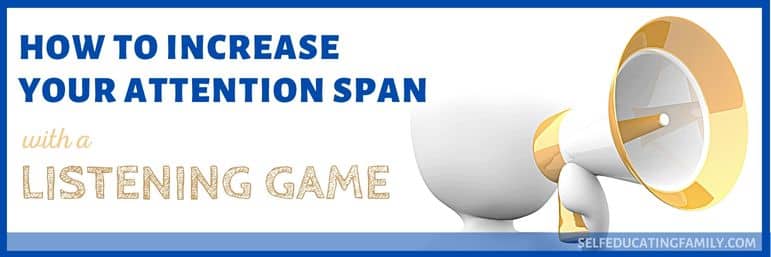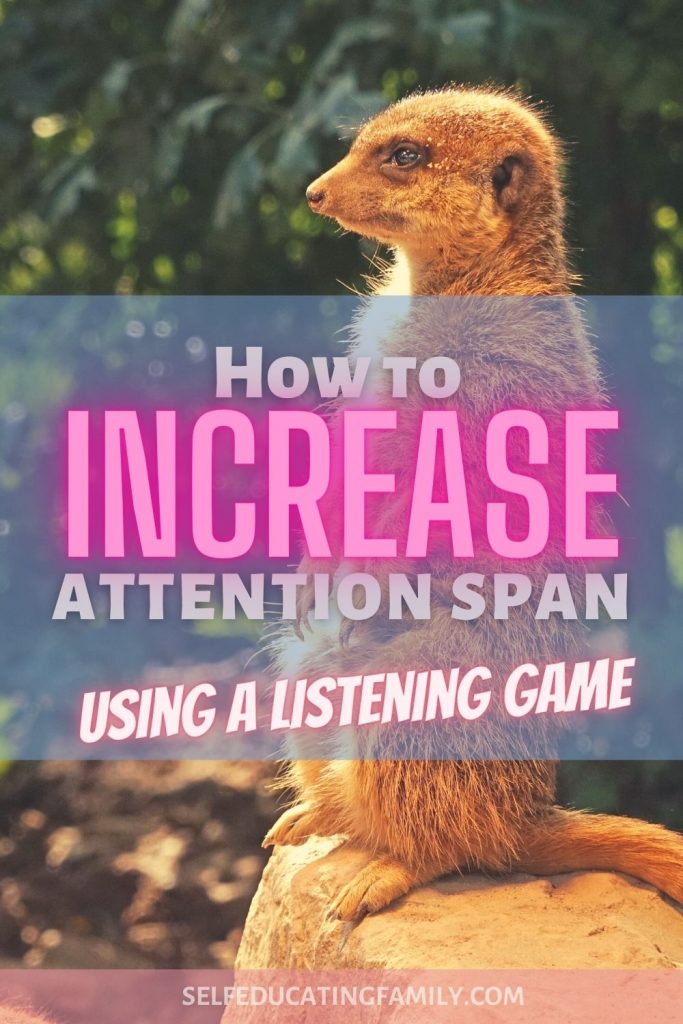Use this simple DIY listening game to increase attention span
Do you need help learning how to increase your kids’ attention span?
Have you ever used a game board to help improve listening? To help your kids really focus on a story and at the same time improve their attention skills?
This game might be for you.
Note: I did not invent this game, but I found it long ago on the internet and have made my own game boards for years. Sorry if you invented the game because I no longer know where it originated!
The Game
I’m going to show you a sample of the Listening Game that I made for a section of the Longfellow poem called The Song of Hiawatha. This was for section III: Hiawatha’s Childhood. It’s the famous part – “…By the shores of Gitchee Gumee…”.
I’ll also give you a blank board so you can print out your own listening game board to customize for your current family read aloud.
But first, why did I make these in to begin with? And can you use a game to increase your child’s attention span?
Do you need to increase your attention span?
There was a famous study done in 2015 that showed our attentions spans have dropped to 8 seconds, which is 1 second less than a goldfish.
The study has had some rebuttal; for instance, the BBC reported on a psychologist that contends that attention is actually task dependent. Which makes sense if you ever watched your kids have infinite attention for something they are interested in as opposed something like doing a math worksheet.
Seriously, I don’t want to send you down a rabbit trail on how much attention span we have or don’t have – you can google these things later. But not right now.
FOCUS!
The question at hand is not how much attention span we have, but how can we cultivate the ability to master our focus?
If you are homeschooling, you can see the definite advantage of having your kids master their own ability to pay attention, but everyone could use a boost in this area since we live in world chock full of distractions!
Listening carefully to a story that is read aloud can help increase your attention span.
Now, your kids might be so focused when you read aloud as a family that they make those Mayan children[i] look like they have the attention span of a flea, but chances are that is not the case. And it usually isn’t the case at an early age, unless they have been taught to develop their ability to increase their attention span, like those Mayan kids.
By the way, reading aloud as a family counts towards your “always reading a book” as well as your kids’! It’s a win-win deal.
What is the Habit of Attention?
Going back to the Charlotte Mason method of home education, the habit of attention is one you want to actively nurture. Read here for more in depth on how to apply her methods to attention or here to read more on how using short lessons can also increase attention spans.
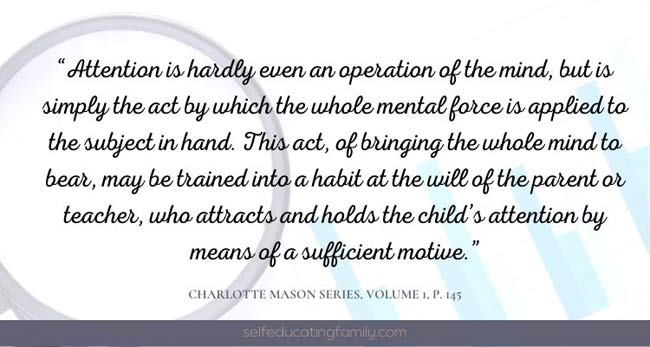
Attention, as a habit, is a great one to start with if you are habit building, because many other habits build on it. For instance, if you are good at paying attention, it is easier to remember what you learn.
Listening as a skill
So how does listening fit in?
If you want a simple answer, active listening means that the person is “tuning in” to a speaker, trying to have complete comprehension. Compare that to passive listening, where you hear what is going on, but are not fully engaged – passive listening sometimes means the listener will tune out the speaker.
So active listening is better for learning because it engages the brain more.
Types of learners
You’ve probably heard of the concept that there are different types of learners. Brain scientists continue to understand more about the brain, so for simplicity’s sake, let’s briefly mention one way to divide up the different types of learners:
- Auditory – learn best by hearing
- Visual – learn best by reading or watching
- Kinesthetic – learn best by doing or using their hands
If you keep this in mind, listening to a book is going to be easier for some people than others. Namely, it will be easiest for auditory learners.
I am a visual learner, and it was always difficult for me to simply listen to a lecture. To overcome that, I took copious notes and loved when they wrote on a board during lectures. It took me a while, but I have learned through practice to listen to books on tape with good comprehension. I still have trouble with podcasts and prefer to read a transcript.
What to do with kinesthetic learners?
One of my sons is a kinesthetic learner. So it was very hard for him to sit still and listen and actually hear what was said. Sometimes, simply doing something with his hands during a read-aloud session increased his understanding and his attention span.
We’ve tried numerous ways to actively engage our brains over the years. One of the more successful was this listening game.
And it works with multiple ages
Another bonus to this game is that it works multiple ages– from the small kids to the big (even adult) kids!
So how does the listening game work?
Given that I am a visual learner, I’m glad to show you a sample game board.
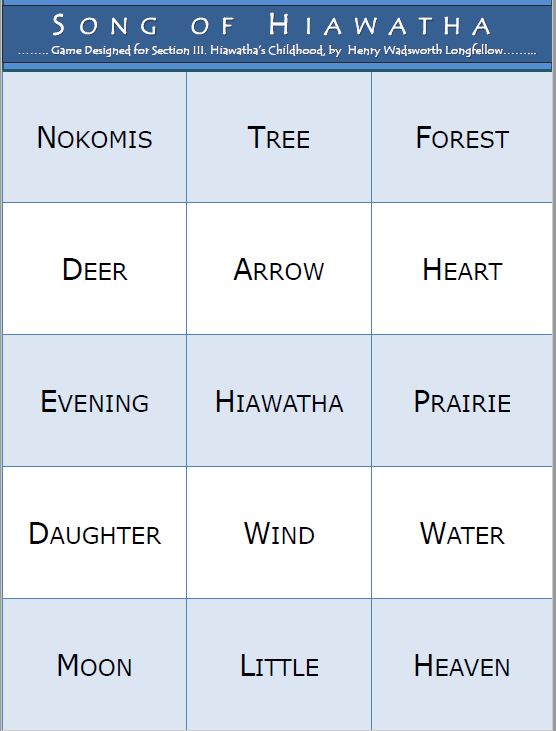
This is the listening game board for Hiawatha.
The game board is a bit like a bingo card. Every player gets one. The board should be specific to your reading and has each square filled with a word from the story.
What you need to play
- Reading material
- Game board for each player based on the specific reading material
- Answer key for your reading
- Lots of small markers in bowls
- Markers could include pennies, chocolate chips, raisins, grapes, small snack crackers, popcorn.
- Think of these as tiny motivation markers.
Setup
- Place markers in numerous bowls within reach of each player.
- Place game board in front of each player.
The Play
- The narrator reviews the words in the game squares.
- If there are pre-readers, it’s good to use a game board with pictures.
- The narrator asks if everyone is ready and then begins reading.
- Players place one marker on a square when they hear that word read from the story.
- Play continues until a pause in the story.
The Pauses
- The narrator can take regular pauses to check in on the players.
- Pauses can be used as a narration practice by asking questions about who heard what.
- Pauses are a good time to compare quantity of markers on the cards with the answer key.
- Did anyone miss words?
- Did anyone hear too many of a word?
Everyone wins
This is not really a competitive game and everyone gets to win and eat their winnings. Except the narrator, but maybe someone will share with you.
How does this fit in with Narration?
As a side note, the listening game can be enhance narration as well as attention span. When you pause periodically in the reading and check in on the results to see who has heard what, that can be a form of narration.
And at the end of the game, you can ask for a summary of the story while the players are munching on their winnings.
Remember, telling it back (narration) makes the content “stick” better.
Narration increases learning
So we see that the ability to pay attention is linked directly to your ability to learn stuff.
The very first step to learning is paying attention.
In an article called Academic Gains Through Improved Learning Effectiveness, the University of Maine states that “The very first step to learning is paying attention.”
Back to our game
So that is the game in a nutshell. I’ve got a blank game board for you that you can laminate and use with an erasable marker to fill in the words if you’d like to customize the game for a particular story.
Ideas for customizing the game
If you are reading a poem or short story that you have the text for (for instance, if you found the text on Project Gutenberg), dump the whole text into a word sorter like Word Art (which generates a word cloud) and you can see the most popular words and how many times they are used.
Why would you want to know which words are most used?
The only reason for getting a word count in this game is to make sure you don’t have 6000 chocolate chips on one word. I’ve used the “special” treat for a word that is only used once in the reading – like a giant cookie – just to see if they are really listening. It can sometimes help them focus.
For long books
If you are reading a long chapter book that you are familiar with, you would want to set up the squares with generic words. For instance, for a book like Five Children and It by Edith Nesbit, you could put each kid’s name in a square and then words like Psammead, wish, sunset, gold, etc.
For long books, you probably don’t want to use the game board for every chapter. Pull it out once in a while if attention seems to be flagging. Consider it a way to vary your narration opportunities. Theoretically, if you are reading “living books”, your family should enjoy listening to them because they are rich with ideas. Even if it is a math living book!
For further study
- Narration: For some narration resources with a free infographic on the basics of Charlotte Mason-style narration, see my guest post that I wrote for the Unexpected Homeschooler
- The goldfish study
- The goldfish study rebuffed
- Energizing Brain Boosts for mini-activities between lessons to keep focus high.
Boards to download
For now, download the Hiawatha board and the blank board instantly while supplies last. Soon, they will only be available when you sign up for my newsletter to get access to all the free printables in my library.
Here are the sample board of Hiawatha and the blank board you can download now.
Conclusion
Listening games can help tune your children in to a read aloud session and help them to improve their ability to keep focused attention for longer periods of time.
Hope you’ve enjoyed this look at a listening game to increase attention span.
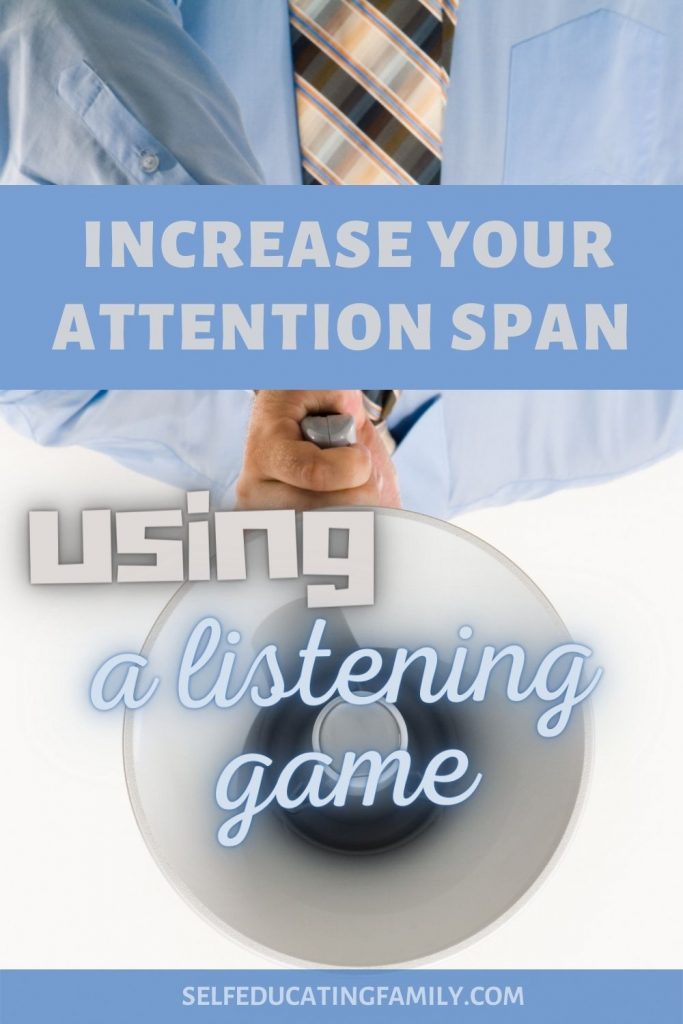
[i] The famous study on Mayan kids who have incredible attention spans
